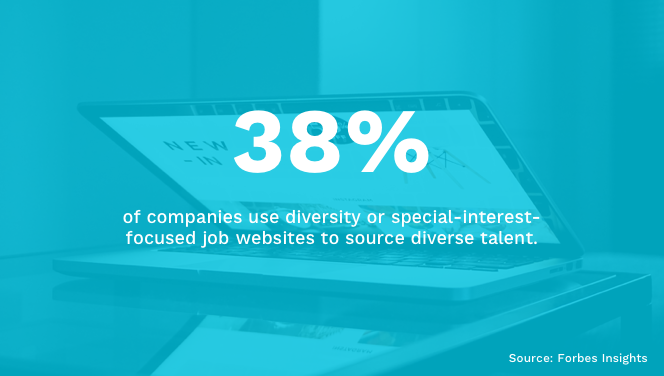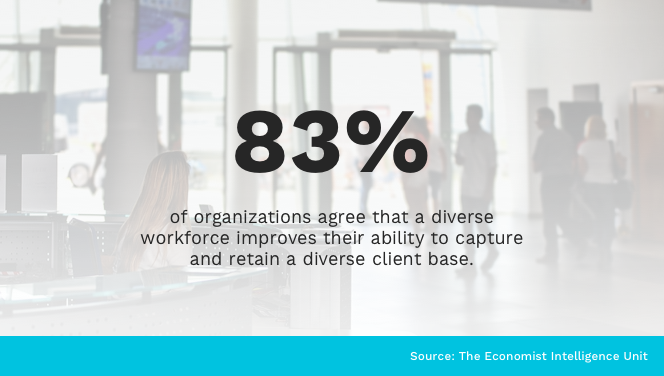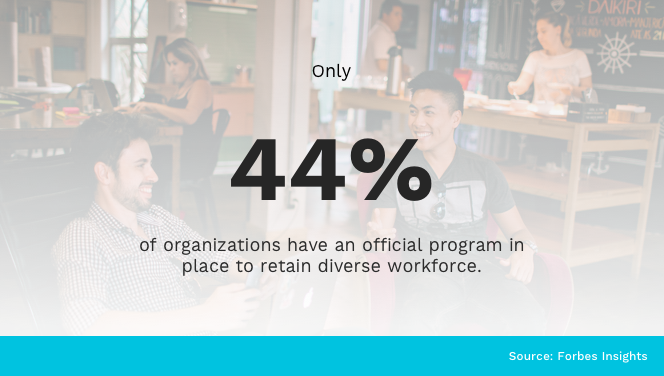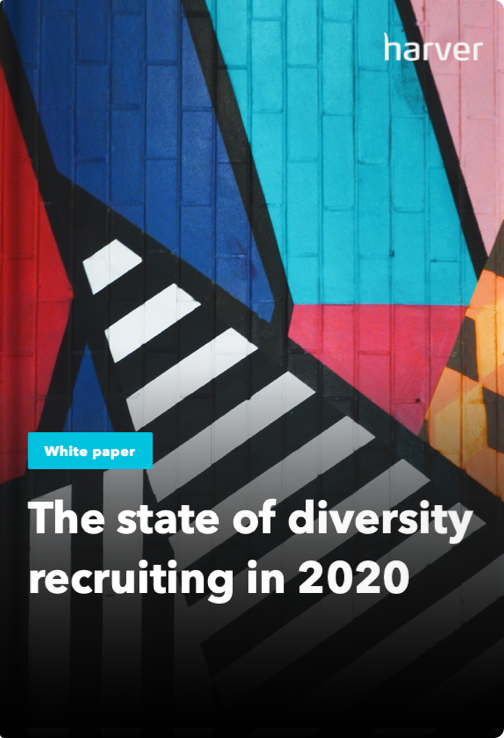This article is based on an interview of the Harver editorial team with Anna Chalon from Frame.io.
It’s well documented that diverse teams make for better teams and ultimately lead to more successful business outcomes. The more diverse a team is, the more perspectives there are, the more creative they are, the better they are at problem-solving, at staying competitive in a busy marketplace.
And this is beside empowering underrepresented groups in the workforce. According to a McKinsey report, gender-diverse companies are 25% more likely to outperform their peers, while ethnically-diverse businesses are 36% more likely to perform better than their competitors.
Yet despite knowing these benefits of diversity, many companies struggle to implement a successful diversity recruiting strategy. And a lack of diversity creates a vicious cycle since the lack of representation will deter people who are different to enter the field.
So what can you do to improve your diversity recruiting strategy?
We caught up with Anna Chalon, Director of Recruitment and Diversity and Inclusion (D&I) at frame.io to discuss initiatives around increasing diversity and inclusion during recruitment.
Anna shared her experience with diversity recruiting and gave 9 practical tips to improve your diversity recruiting strategy.
What’s in?
Like what you see?
Don’t miss out. Subscribe to our quarterly digest to get the latest TA and TM resources delivered right to your inbox.
1. Look at your current culture to make sure it’s inclusive
The first thing you should do to improve diversity in your company is to take a long hard look at your current culture to see if it’s inclusive or not. Look at:
- your attrition data and conduct a survey with tools such as Culture Amp – they’ll reveal if one group of employees is more unhappy than the other.
- what kind of events are being hosted to bolster company culture. Is there always alcohol involved? Do these events always take place after hours?
- who is getting promoted or who is receiving raises or who is speaking at company meetings.
- what is being celebrated with Black History Month or Women in History month, for example.
- implementing a D&I committee.
- your office space, in particular things like bathroom signage or the name of the conference room.
Building an inclusive environment is a succession of “little things” and messages that make it clear that everyone belongs and that everyone has equal opportunity to succeed. It can be done at little to no cost by simply being thoughtful, being curious and taking steps to truly understand the experience that employees from all backgrounds have at your companies and in the workplace overall.
If you have over 100 employees, look to measure progress across all diverse categories, not just gender. However, if you are a smaller company, this can be difficult to track and protect anonymity while you do it. Instead, you could look into conducting qualitative interviews with your team members while ensuring confidentiality.
Once you’ve done this, take a look at how you’ve been recruiting in recent years and question everything, otherwise nothing will change. If it seems like hard work that’s because it will be in the beginning, but once you’ve changed one thing, it’ll make it easier to change the next thing and then next.
And if you think it’s hard work and that some conversations can feel uncomfortable – good news, it means you’re doing something right! Challenging our beliefs and putting ourselves in a vulnerable position by asking questions, educating ourselves and having sensitive conversations is a small price to pay to help create a safer and more equitable environment for all. And especially for those who have been dealing with conscious and unconscious biases and full on or even micro aggressions on a daily basis. Being a real ally starts there.
As Anna Chalon says, “it’s hard for people to recognize and admit their own biases as there’s a sense of shame attached to it. I think it’s important to remove the judgement from it and recognize that our biases have been shaped by the world we live in and that we need to work on it.”

2. Write inclusive job descriptions that can appeal to everyone
Referring to the applicants as ‘you’ instead of the third person is a great way to write inclusive job descriptions, especially when it comes to gender. Women tend to respond less well to job adverts when they’re written in the third person rather than ‘you’.
Use the term ‘salespeople’ rather than ‘salesmen’, or talk about the ‘chair of the board’, rather than call them the ‘chairman’ or ‘chairwoman’. Don’t assign gender to a role, it’s irrelevant and off-putting and makes it difficult for women to identify and want to pursue a career in that role.
Unless it’s strictly pertinent to the role in question, another great diversity recruiting strategy is to remove college requirements from the advert or at least refrain from mentioning top colleges. Not every top tier candidate will have been able to afford to go to a great college, and vice versa, not every top college graduate will be a great candidate for your role.
While you’re at it, look at the ‘requirements’ you have for the job role. Are they really requirements, or just hangovers from the way you used to recruit? Unnecessary requirements can have you looking at things that don’t matter, making you disqualify perfectly qualified candidates, which could be impacting your diversity recruiting strategy.
Another good thing to look for are the gender-connotative words such as ‘ninja’ or ‘rock star’. Use a tool such as Textio to help check your job description – it will look for words that could potentially be off-putting to women or candidates from under represented groups.
3. Source and attract a diverse pool of candidates
Instead of simply posting your job advert on the major job boards and assuming it will be looked at by all and sundry, consider actively going after candidates from diverse backgrounds.
- Post on less traditional job boards, for example, Diversity.com, Black Career Network, iHispano, or Fairygodboss.
- Post on a college job board for underrepresented groups or under-resourced students.
- Look at your employer branding and make sure you’re featuring employees and events at your company that represent your diverse culture. Just make sure it’s genuine and this is actually your culture or you run the risk of damaging your reputation by being fake.
- Go to conferences or host events specifically for underrepresented groups, i.e. LGBTQ in technology.
If you can showcase your diversity and take the time to source with diversity in mind, you will be presented with a broader pool of candidates to recruit from.
Another great way to source candidates from diverse backgrounds is to encourage employees to refer people who don’t look like them. This is something Anna Chalon says is very successful at Frame.io.
During their onboarding process, they ask all new employees to think of someone who would do well at Frame.io and then to take a second to think of someone else for that same role, someone who doesn’t look like them, who hasn’t immediately sprung to mind, and refer them too.

Popular diverse sourcing strategies also include collaborating with university/graduate school diversity associations, search firms, and participating in diversity-focused job fairs.
4. Use assignments as a first step in the process when possible
Using pre-employment assessments in the recruiting process is a great way to select potential candidates, especially for junior roles. Tweak the interview process to assess candidates’ skills and abilities first. This way you don’t have to base your judgment solely on their resumé.
By assessing all candidates with the same test, you will give candidates a chance to prove themselves, especially if they have an untraditional background.
The state of diversity recruiting in 2020
5. Have a diverse interview panel
Like attracts like – candidates want to be able to see themselves represented in your company. Plus, the more diverse your interview panel, the better it will be for your organization too, as everyone looks for something different in candidates and could see potential where others cannot.
As a minimum rule, never have an all-white, all-male panel.
As Anna Chalon says, “As people, we tend to gravitate towards people who look like us, so it’s important to recognize that and work around it in order to build a diverse culture with people from varied backgrounds and experiences.”

Organizations consider retaining a diverse client base one of the primary benefits of a diverse workforce.
6. Implement unconscious bias training for all
Host unconscious bias training for everyone, and make sure that all new recruits take part in their first three months of working with you. You can run sessions in-house, or get a third party to train your employees.
Just make sure that everyone, and not just those responsible for recruiting, attends. You want your whole organization to be open and inclusive and making everyone aware of unconscious bias can help you all succeed.
Remember, unconscious bias doesn’t just happen during recruiting, it is prevalent during promotion too. We can have a tendency to favor those who are similar to us, meaning that if you have a manager who isn’t trained or a team leader who holds unconscious bias, they could unintentionally be helping employees they feel an affinity too, rather than treating everyone equally.
However, when educating your employees about fighting unconscious bias, don’t forget about limitations of such training. You shouldn’t emphasize the individual responsibility over larger structural changes and think that it will erase the broader issues of discrimination and inequity in the workplace.
7. Build a structured interview process
This is really important to eliminate interviewer bias and ensure that the hiring decision isn’t made based on gut feelings or hiring the people who you are most comfortable talking to. This is especially vital if your company already lacks diversity.
Make sure there’s a well-defined interview process with clear questions so that every candidate can be assessed on the same criteria. And that no interviewer deviates from these set questions.
This will also ensure that you can deliver a great candidate experience too, by keeping all candidates on a level playing field, you can’t favor one over another on anything other than a strict set of criteria.

Structuring your interview process not only helps you eliminate bias in your recruitment efforts but it also helps you better predict candidates’ success on the job.
8. Have a proper wrap up with a recruiter present
Make sure your diversity recruitment strategy is ongoing by having a debrief after every candidate comes on site, or has a remote interview.
Have everyone share their feedback during a wrap-up with an experienced recruiter who can observe and call out potential biases based on language and adjectives being used to describe candidates. It’s helpful to pay attention to patterns.
Historically, interviewers were less likely to think a woman had strong “leadership skills” for example, or less likely to think that an “older” software engineer could be very technical. So these are all biases to watch out for to ensure you can hire the best person without being limited by unfounded beliefs.
9. Track your progress
One way to make sure you’re on track is to track your progress and report on how you’re doing by looking at the EEOC self-identification forms either during the application process, through the applicant tracking system, or through your HRIS system once people are actually hired.
- Report quarterly on your efforts, your gender breakdown, or your further diversity breakdown.
- Report annually on promotions and salary increases.
Hold yourself accountable by tracking your progress and making adjustments when the results aren’t there. If you see high levels of attrition in one cohort, work to understand what is happening to make those particular employees churn, and implement measures in the company to create a safe and equitable environment where everyone has equal opportunity to succeed.
You could look at implementing ERG groups (employee resource groups) or building a mentoring program among other initiatives.

Improving your retention strategy is just as important as enhancing your diversity recruiting strategy in building an inclusive workplace.
To wrap it up
Improving your diversity recruiting strategy is a great way to ensure your company flourishes. But it’s important to remember that diversity doesn’t begin and end with the recruitment process.
You need to make sure that diversity and inclusion comes from the top-down and the bottom up. So don’t just focus on “hiring diverse employees” but really look to have a truly inclusive culture with great allies at all levels. Train employees and managers regularly on unconscious bias and make sure you’re investing in and promoting employees from underrepresented groups equally.
| About Anna Chalon: Anna was born and raised in Paris, France. After studying law and pursuing a singer-songwriter career, she’s now been working in the tech industry for the past 6 years. She started as a Recruiting Coordinator and moved quickly up the ranks. She led Recruiting at a Marketing SaaS company, Percolate, for a few years before joining Frame.io, a video collaboration software, as the Head of Recruiting and D&I. She joined as the 50th employee and has helped grow the company to over 170 employees. Frame.io is still growing rapidly. |
If you’d like to learn more about the recruitment software developed by Harver and how it supports companies in building a more diverse and inclusive workforce, you can check the articles below, or book a demo with our team.


